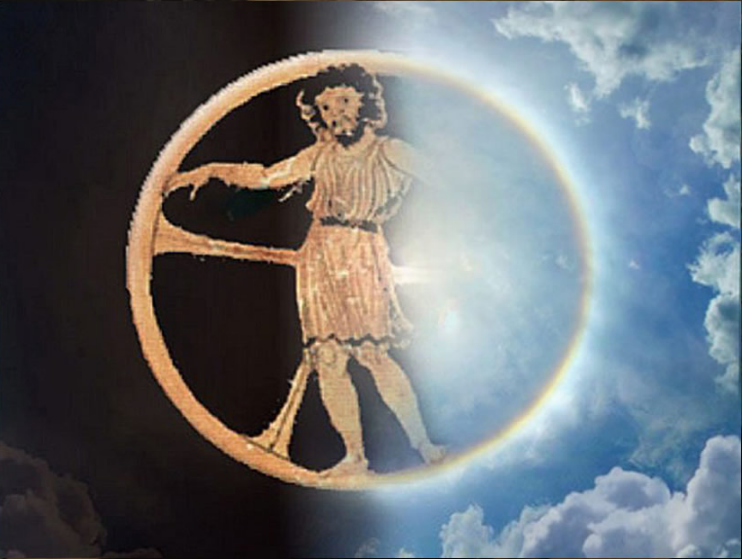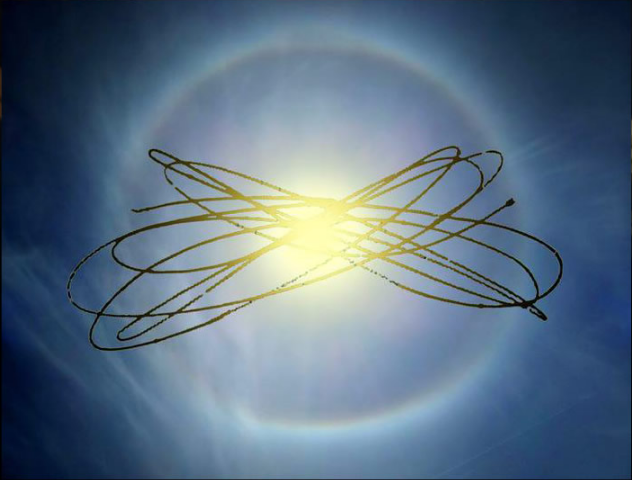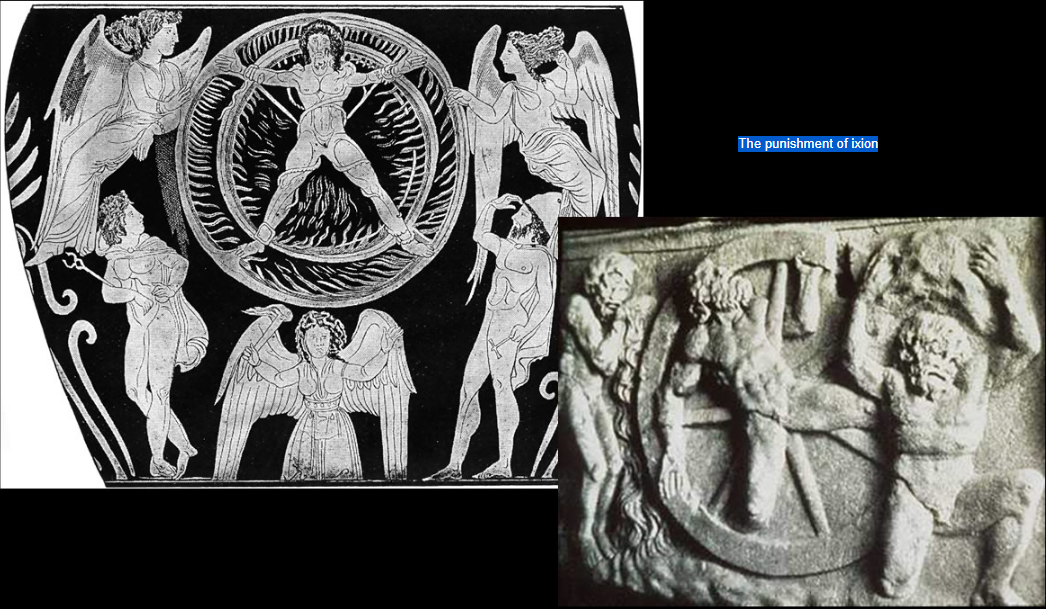Halos, The Myth of Ixion
Halos, The Myth of Ixion: A Deeper Look into the Ancient Greek Legend
Halos, those captivating optical phenomena that grace our skies, have long fascinated humanity. While many cultures have incorporated halos into their mythology, Ancient Greece, with its rich tapestry of legends, curiously lacks specific references to these luminous rings. However, a fascinating theory put forth by archeoastronomer and astrophysicist Paolo Colona suggests a connection between the myth of Ixion and the 22° halo. In his paper published in the journal Mediterranean Archaeology and Archaeometry, Colona presents a compelling argument that the Greeks may have seen the fiery wheel of Ixion's punishment as a representation of the 22° halo.
The Myth of Ixion: A Tale of Transgressions and Eternal Punishment
Ixion, the mythical king of Thessaly, was notorious for his misdeeds. His story begins with his marriage to Dia, daughter of Eioneus. However, Ixion conveniently neglected to fulfill his promise of bridal gifts to his father-in-law. In a fit of rage, Ixion threw Eioneus into a pit of burning coals and wood, becoming the first murderer in Greek legend.
None of the nobles were willing to absolve Ixion of his crime, leaving him in a state of impurity. It was Zeus himself who took pity on Ixion and invited him to Mount Olympus for purification. However, Ixion's gratitude was short-lived as he attempted to seduce Zeus' wife, Hera. In response, Zeus transformed a cloud named Nephele into a likeness of Hera. The union between Ixion and Nephele resulted in the birth of Centaurus, the progenitor of the Centaurs.
Zeus, enraged by Ixion's intentions towards Hera, devised a dire punishment for him. He instructed Hermes, the messenger of the gods, to bind Ixion's hands and feet to a winged and fiery wheel. Thus, Ixion was condemned to roll on this wheel for eternity, forever paying the price for his transgressions.
Unveiling the Connection: The 22° Halo as Ixion's Fiery Wheel
Colona's theory posits that the 22° halo, commonly observed in Greece during the rainy seasons, may have been associated with Ixion's punishment. He presents several intriguing points to support this hypothesis:
- The 22° halo, with its red inner edge, resembles a ring of fire. This fiery characteristic aligns with the notion of Ixion's wheel being a representation of the halo.
- Nephele, the cloud involved in Ixion's attempted dalliance with Hera, is closely associated with the halo. In earlier versions of the myth, Ixion's punishment was also depicted as sky-borne. The connection between Nephele and the halo strengthens the argument for the halo being Ixion's fiery wheel.
- Rain is often linked to both the myth of Ixion and the appearance of halos. The halo can serve as a precursor to a warm front accompanied by heavy rain, further supporting the idea of its association with Ixion's punishment.
Moreover, Colona draws attention to the alignment between the greatest elongations of Mercury, known as Eρμάων or Eρμής in Ancient Greek, and the 22° halo. In Greek mythology, Zeus assigned Hermes (the Roman equivalent of Mercury) the task of binding Ixion to the wheel. The Greeks may have envisioned Hermes darting back and forth across the wheel to secure Ixion in place.
Exploring the Enigmatic Absence: Halos in Ancient Greek Mythology
While the connection between the 22° halo and the myth of Ixion offers a fascinating explanation, it raises the question of why halos are not explicitly mentioned in Ancient Greek mythology. Given the prominence of halos in Greece, particularly during the rainy seasons, their absence in mythology seems perplexing.
One possible explanation is that the Greeks simply did not attribute a specific mythological significance to halos. Ancient Greek mythology encompasses a vast array of gods, goddesses, and mythical creatures, with each phenomenon often associated with a specific deity or legend. Halos may have been viewed as natural occurrences rather than divine or supernatural manifestations, thus not warranting inclusion in the pantheon of Greek myths.
The Beauty and Mystery of Halos
Regardless of their absence from Ancient Greek mythology, halos continue to captivate our imagination with their ethereal beauty. These optical phenomena arise from the interaction of sunlight with ice crystals suspended in the atmosphere, resulting in the scattering and refraction of light.
Halos manifest in various forms, including the 22° halo, which appears as a ring around the sun or moon. Other halo types, such as the circumscribed halo, can exhibit even brighter and more saturated colors. These celestial displays add a touch of magic to our skies, reminding us of the wonders that exist beyond our earthly realm.
As we gaze upon the luminous rings encircling celestial bodies, let us appreciate the scientific explanations behind these captivating phenomena while also cherishing the mythical connections that enrich our understanding of the world around us. Whether they be the fiery wheel of Ixion or simply natural wonders to behold, halos continue to inspire awe and wonder, reminding us of the interconnectedness between science, mythology, and the beauty of our universe.

The myth of Ixion
King Ixion, pictured on an Ancient Greek vase. He is tied for ever to a rolling fiery wheel. Here he is measured against a 22° halo..
Image ©Paolo Colona, shown with permission
The Myth of Ixion
Ixion was the mythical king of Thessaly and something of a bad lot.
He married Dia, daughter of Eioneus, but conveniently overlooked payment of the promised bridal gifts to his new father-in-law. A feud resulted with Ixion throwing Eioneus into a pit of burning coals and wood. The first murderer and Cain of Greek legend. None of the nobles would purify him of the crime and eventually Zeus himself took pity and invited him to Mount Olympus for purification.
One crime was not enough Ixion. On Olympus he rewarded Zeus' generosity with an attempted dalliance with his wife Hera. Zeus, understandably less than pleased, transfigured a cloud, Nephele, into a resemblance of Hera. The resulting union with Ixion produced Centaurus (pokewind) the sire of the Centaurs.
Ixion’s punishment, having proven his intentions towards Hera, was dire. Zeus instructed Hermes to tie his hands and feet to a winged and fiery wheel on which he now rolls for all eternity.

Paths of Mercury (Eρμάων) relative to a fixed sun from 1990 - 2016. The average greatest elongation happens to be 22.4 degrees, the radius of the halo.
.In this image and likely the top one the brightest halo is actually a circumscribed halo. At high sun this halo shrinks to an oval close in size to the 22 degree halo. The sun gets high in Greece!
The 22° halo and others are common appearances in Greece, at least during the more rainy seasons.
It is therefore puzzling that halos have little or no place in Ancient Greece’s rich mythology. Perhaps there is now one for the 22° halo.
Archeoastronomer and astrophysicist Paolo Colona has published a paper in the journal Mediterranean Archaeology and Archaeometry where he interprets the myth of Ixion and argues that the Greeks saw the 22° halo as the fiery wheel.
Paolo argues:
The 22 degree halo follows the sun and is sometimes visible for hours. With its red inner edge it might be thought of as a ring of fire. OPOD comment: A high sun circumscribed halo is often even brighter with more saturated colours and would also fit this requirement.
The halo is well associated with Nephele, the cloud. The scene of ixion’s union with Nephele is in the skies (the home of Zeus) and in earlier tradition his punishment was also sky bourne. The wheel is often described as flying or winged.
The myth is also linked with rain and the halo if often the forerunner of a warm front with heavy rain.
The 22° halo matches greatest elongations of Mercury - Ancient Greek, Eρμάων or Eρμής. Zeus tasked Hermes (the Roman Mercury) to bind Ixion to the wheel. The Greeks might have imagined Hermes darting back and forth across the wheel to tie Ixion in place.

The punishment of ixion
Note: this article has been automatically converted from the old site and may not appear as intended. You can find the original article here.
Reference Atmospheric Optics
If you use any of the definitions, information, or data presented on Atmospheric Optics, please copy the link or reference below to properly credit us as the reference source. Thank you!
-
<a href="https://atoptics.co.uk/blog/halos-the-myth-of-ixion/">Halos, The Myth of Ixion </a>
-
"Halos, The Myth of Ixion ". Atmospheric Optics. Accessed on December 25, 2024. https://atoptics.co.uk/blog/halos-the-myth-of-ixion/.
-
"Halos, The Myth of Ixion ". Atmospheric Optics, https://atoptics.co.uk/blog/halos-the-myth-of-ixion/. Accessed 25 December, 2024
-
Halos, The Myth of Ixion . Atmospheric Optics. Retrieved from https://atoptics.co.uk/blog/halos-the-myth-of-ixion/.